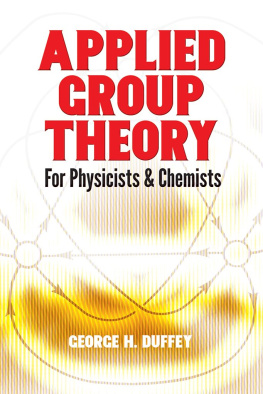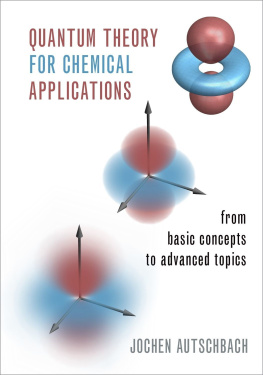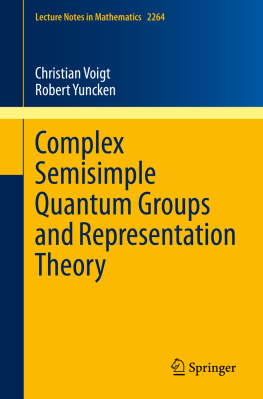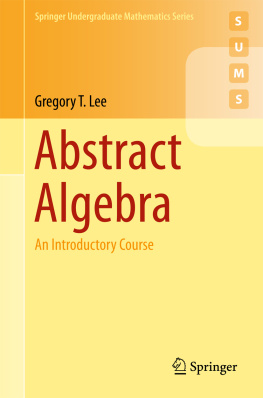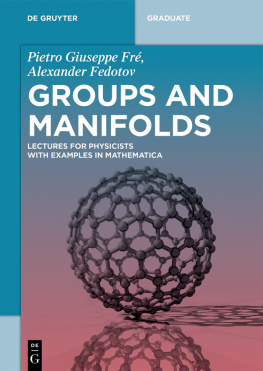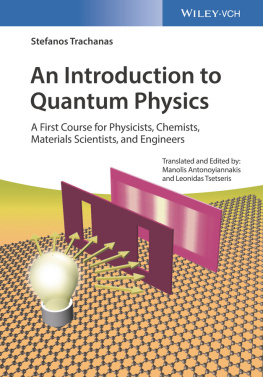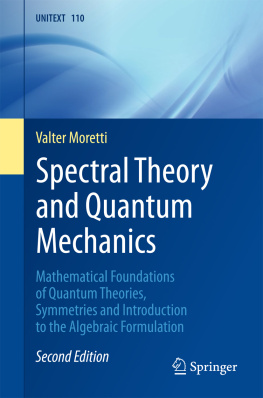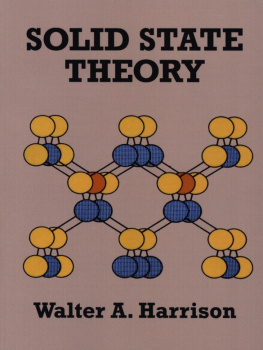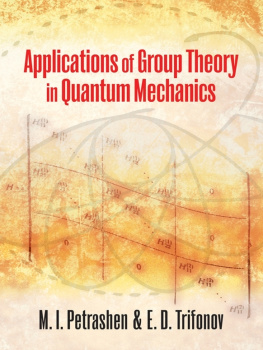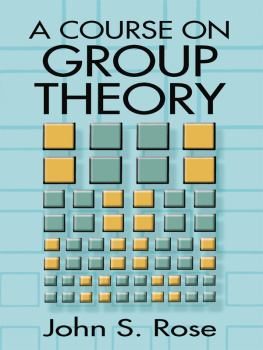APPLIED GROUP THEORYFor Physicists & ChemistsGEORGE H. DUFFEY South Dakota State University Dover Publications, Inc. Mineola, New York Copyright Copyright 1992 by George H. Duffey All rights reserved. Bibliographical Note This Dover edition, first published in 2015, is an unabridged republication of the work originally published in 1992 by Prentice-Hall, Inc., Englewood Cliffs, New Jersey. Library of Congress Cataloging-in-Publication Data Duffey, George H.
Applied group theory : for physicists and chemists / George H. Duffey. Dover edition. p. cm. Originally published: Englewood Cliffs, NJ : Prentice Hall, 1992.
Includes bibliographical references and index. eISBN-13: 978-0-486-80132-2 1. Symmetry (Physics) 2. Group theory. 3. 4. 4.
Chemistry, Physical and theoretical. I. Title. QC174.17S9D84 2015 530.1522dc23 2014028695 Manufactured in the United States by Courier Corporation 78314601 2015 www.doverpublications.com Preface This work introduces students to the aspects of group theory that are most important in applications. As such, it can serve as a text for a senior or first-year graduate course taken by physicists, chemists, and applied mathematicians. In the development, concrete examples accompany the abstract development.
Thus, understanding and usefulness are enhanced. Since the primary applications of group theory are to symmetric structures, the nature of symmetry operations is considered first. How these make up a group is noted. Then the structures of key groups are described using generators and Cayley diagrams. Classes of group elements are defined, class sums formed, and the characters for symmetry species determined. Their use in constructing symmetry-adapted structures for physical systems is then developed.
Applications are made to vibrating systems, to continuum mechanics, to quantum structures. The text then contains considerable material on product systems. Some special techniques needed for permutation groups are developed. These include the development of Young tables and diagrams. How spin and orbital states combine is thus elucidated. Each piece of a continuous group is generated by infinitesimal operators.
These combine to form a Lie algebra. In this algebra commutation relations play a key role. Thus, we obtain a basis for the use of these relations in angular-momentum theory, in fundamental-particle theory, in general quantum mechanics. How bilinear products of creation and annihilation operators lead to Lie algebras is considered. Thus, a basis is laid for quark theory, for interpreting particle multiplets. CHAPTERSymmetry Operations1.1Causality and Symmetry The universe is not a single indivisible whole.
Instead, it consists of parts that can act independently in spite of interactions binding the parts together. This feature allows observers and observing instruments to exist. It also permits both analysis and synthesis to proceed. An observer first notes that events in his life fall in order; he experiences time locally. Second, whatever he observes can be located at points or small regions in a 3-dimensional space based on his own position at the time of observation. Similar relationships presumably prevail for an observing instrument.
Time is not observed as a global entity but as an independent property of the observing point or small region. It behaves as a directed coordinate orthogonal to the three spatial coordinates of the point. Furthermore, an interval of time can be measured by the distance traveled by a photon in the interval. Consequently, the arena in which phenomena occur is a 4-dimensional continuum in which a displacement may be oriented to be either timelike or spacelike. In constructing science, one seeks out the patterns that exist among the observations. One presumes that the material world is not capricious or lawlessthat it is not governed by spirits as primitive man believed.
If certain events appear to follow as a consequence of particular conditions, these events are said to be caused by the conditions. Thus in Newtonian mechanics, one says that the acceleration of a body is caused by the net force acting on it. In principle, uniqueness need not prevail. A given set of conditions, a given cause, may lead to various possible results rather than to a single result. Then degeneracy is said to obtain. For instance, the radioactive nuclei in a sample may be shown to be identical by statistical tests.
Nevertheless, they will disintegrate at random times with a definite half life. In general, we will call the part of the universe under study a system. The system may be subdivided in various ways. And the resulting parts maybe further subdivided. Each of the subsystems maybe considered a system in its own right in the approximation that it behaves as an entity. Now, an operation performed on a system may yield an equivalent system with the same spectrum of properties.
The entity under study is then said to possess symmetry. The operation is called a symmetry operation. When these conditions are only approximately satisfied, one says that a near-symmetry exists. The system may then be considered as a pertubation of a corresponding symmetric entity. When the perturbation is small, it may be neglected. Symmetry operations may act in position space, or in the space-time continuum.
They may act in momentum space, or in phase space. Alternatively, they may act in a more general space or plot. Symmetry operations may also involve other attributes besides position and momentum. Examples of these include particle spin, isotopic spin, hypercharge, color. 1.2Common Symmetry Operations For certain properties, the behavior of a system may be governed by a particular function or operator. In classical mechanics, the discriminating function may be a potential, a Lagrangian, or a Hamiltonian.
In quantum mechanics, the discriminating operator may be that for some angular momentum or energy. Now, any system for which distinct operations fail to alter the form of a discriminating function or operator is said to possess symmetry. The operations that leave the pertinent function or operator unchanged are called symmetry operations. Some of the processes that transform a symmetric region into an equivalent region are geometric, while some are not. Others consist of a geometric change combined with a nongeometric change. Each geometric symmetry operation occurs with respect to a structure in the system, a base.
A nongeometric alteration is called a conversion. In magnetic systems, a conversion involves changing the magnetic state of a particle (as when spins are reversed). In colored systems, a conversion involves changing one color to another in a cycle. In particle systems, a conversion may involve changing one particle into another. Symmetry operations often met in dealing with the mechanics of macroscopic and microscopic systems are described in . The geometric processes include reorientations about a base, translations, and translations combined with reorientations.
In symmetric systems, these appear as permutation of like parts. 1.3Reorientation Matrices The reorientations in may be carried out on the physical system or on the coordinate axes. The first kind is said to be active, the second kind passive. Both kinds are described by homogenous linear transformations of appropriate Cartesian coordinates. Such transformations can be represented by linear matrix equations. Where there is a point about which the reorientation is executed, this point is chosen as the origin.
Where there is more than one such invariant point, a representative point from these points is chosen as the origin. The axes are drawn in appropriate directions. The coordinates of a typical point of the system before and after the transformation under discussion are designated (
Next page
